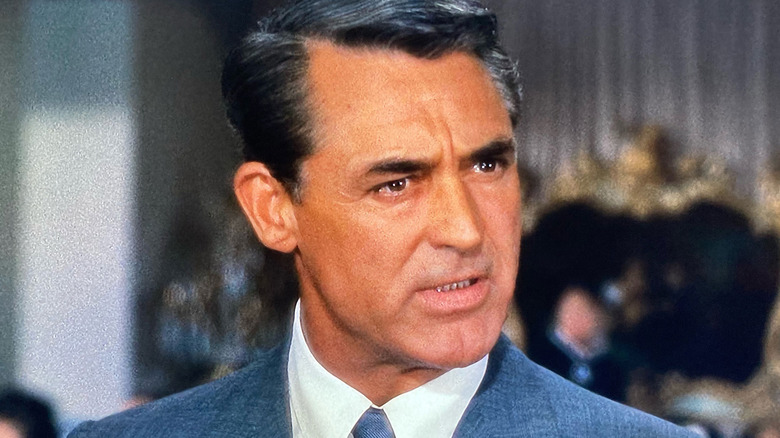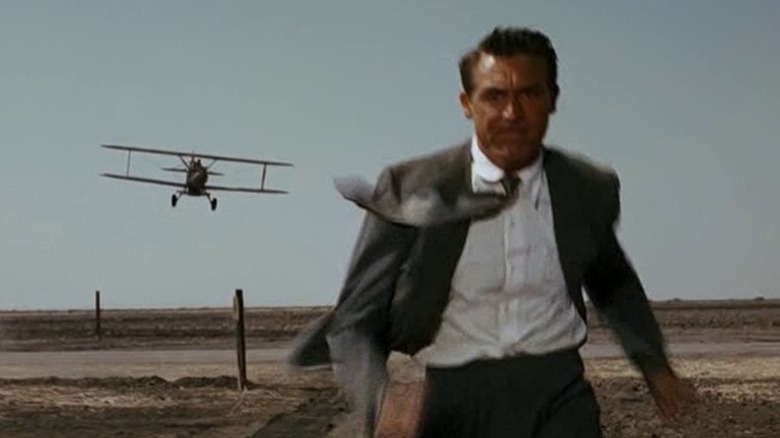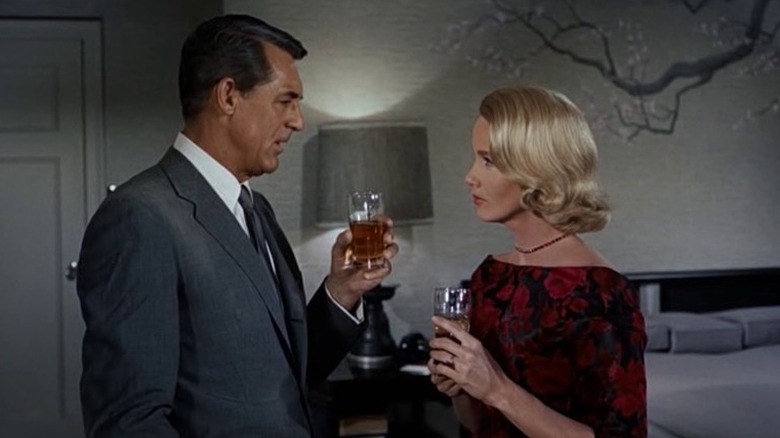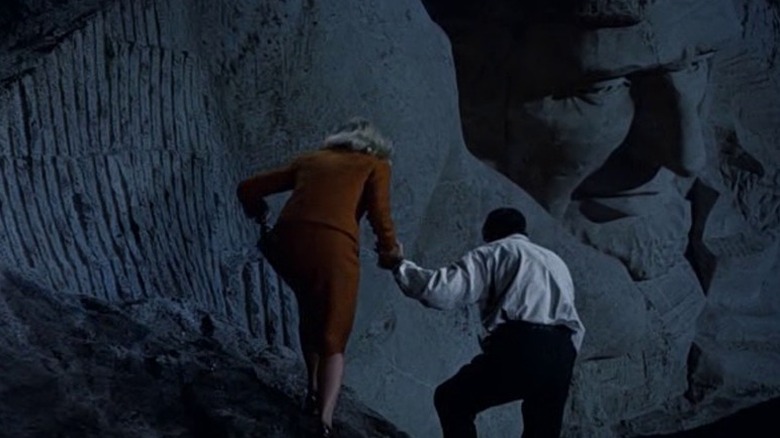North By Northwest Ending Explained: The Ultimate Hitchcock Picture
A man wrongly accused and on the run. A beautiful blonde woman with secrets. A cross-country suspense-filled adventure that brought the two together in a way that just barely escaped the censorship board of '50s America. These were the ingredients of a classic Hitchcock film. And in 1959, they were perfected. Shortly after the release of more psychologically intense films like 1956's "The Wrong Man" and 1958's "Vertigo," Hitchcock longed for something lighter. While collaborating with writer Ernest Lehman on a different project, the two realized they could create "the Hitchcock picture to end all Hitchcock pictures."
Hitchcock and Lehman brainstormed possible setpieces before anything else: a clash at an art auction, a chase across Mount Rushmore, and the famed crop duster attack. There is a plot, full of double-crossing and secret identities, but it's so convoluted you may prefer to just relax and enjoy the charm of its oblivious protagonist, in way over his head. Roger Thornhill (Cary Grant) is a simple advertising executive who fits in with the crowds on Madison Avenue. He is also suspected of being a secret agent, and this case of mistaken identity leads to him being targeted by an enemy spy named Phillip Vandamm (James Mason, one of the few actors suave enough to make Grant look buffoonish).
Vandamm's spies first try to kill Thornhill in a staged drunk driving accident, which leads to his arrest. And his attempt to clear his name makes him look like a murderer at the U.N. General Assembly.
Crop Duster in a Cornfield
While on the run, Thornhill searches for George Kaplan, the spy he's accused of being. He ends up on a train ride to Chicago, where he meets a young blonde woman named Eve Kendall (Eva Marie Saint). Attraction immediately follows, but there's a complication: Kendall is working for Vandamm. Kendall arranges for Thornhill to meet "Kaplan” at a bus stop in the middle of nowhere. The scene plays out in near-total silence — the sounds of cars and the distant noise of a crop duster are all the audience hears.
Little does Thornhill know he's been set up for an assassination by plane. In one of the most suspenseful and memorable scenes in Hitchcock's filmography, he tries to avoid it by diving from road to ditch. It doesn't matter that it's unrealistic or absurd. To Hitchcock, the absurdity was the point: how else do you make a scene of a character avoiding murder feel new, and genuinely exciting? As he told Francois Truffaut in the landmark interview book "Hitchcock/Truffaut," "I practice absurdity quite religiously!"
The Ad Man and the Spy
Thornhill returns to Kendall to confront her about the trap she laid out, and here the actors find intriguing and flirtatious contours in the biting dialogue. Cast against the 20-years-or-so-older Grant, Eva Marie Saint is a perfect foil, steely and sarcastic, who can "tease a man to death without half-trying." Here, she's quite far from the saintly posture of her debut performance in 1954's "On the Waterfront."
He follows her to find Vandamm at an auction house, and ends up in government custody, where he learns the truth: There is no George Kaplan, and the spy that he was confused with doesn't exist. Instead, it's Kendall who's the spy, pretending to be on the side of Vandamm.
Thornhill takes on the role of Kaplan to ensure Vandamm's defeat. The various factions collide at Mount Rushmore, where Thornhill negotiates for Kendall's release. Kendall then shoots him with blanks in the middle of a cafeteria, convincing Vandamm he's dead but furthering their romance. As Kendall's subterfuge is discovered by Vandamm's men, Thornhill sneaks into his mansion to rescue her. Vandamm's purchase at the auction house turns out to contain microfilm with government secrets on it, and he intends to leave the country with it via plane that night, where he will throw Kendall directly off.
Pure Escapism
Naturally, there's a happy ending, as Vandamm is apprehended by the government agent who's been handling Thornhill. But the suspense of the climax, set atop Mount Rushmore, comes from whether or not Kendall will survive as she hangs off.
As Hitchcock later told Peter Bogdanovich, "North by Northwest" was a "fantasy," free of the demands of logic and strict plotting. It's one of his freest movies, in line with earlier travel-heavy classics like "Foreign Correspondent" and "Saboteur," which also climaxes with a duel atop an American landmark. Early on in the movie, Thornhill echoes the intention of Hitchcock and Lehman by telling his secretary that "in the world of advertising, there's no such thing as a lie, there's only expedient exaggeration."
Ultimately, it's the relationship between Cary Grant and Eva Marie Saint that brings the movie to its remarkable and satisfying conclusion. Thornhill rescues Kendall from her fall in the nick of time. Just as Thornhill and Eve Kendall met on a train, they end on a train, newly betrothed. As they embrace, Hitchcock cuts to a cheeky innuendo: the train entering a tunnel at high speed.



